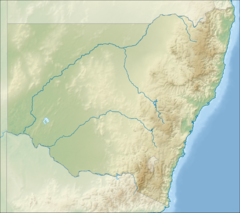Sydney Harbor National Park
| Sydney Harbor National Park | ||
|---|---|---|
| South Head , south exit of the bay | ||
|
|
||
| Location: | New South Wales , Australia | |
| Specialty: | natural stretches of coastline and islands in Sydney Harbor | |
| Next city: | Sydney | |
| Surface: | 3.93 km² | |
| Founding: | 1975 | |
The Sydney Harbor National Park (English Sydney Harbor National Park ) is a national park in the Australian state of New South Wales . The protection of the park was announced in 1975 . 1978 to 1984 the area was enlarged several times.
geography
The national park is located in the urban area of Sydney. It is about 3.93 km². This area is spread over various areas around Sydney Harbor and several islands, such as B. Bradleys Head, Middle and Georges Haeds, North Head , South Head and Harbor Island.
vegetation
About 40% of the area is taken up by heathland , which in places is overgrown again by natural tree vegetation. About 25% of the area - especially in protected locations with deep soils - can be described as woodland . Eucalyptus forests grow on another 15% .
Wildlife
In the national park there are mainly nocturnal mammals, including gray-headed flying foxes , large long-nosed bucks , Stuart broad-footed pouches , the golden-bellied swimming rat , cusus , ring-pouches , echinids and bats .
Around 150 bird species have been observed in the national park so far, 44 also breed here, u. a. Cormorant , masked lapwing , white-bellied sea eagle and gray-headed falcon . There is also a breeding colony of the little penguins here .
history
Long before Australia became a British colony, the area around Sydney Harbor was inhabited by the Aboriginal tribes of the Eora , Guringai and Darug . That changed soon after the arrival of the first European settlers and prisoners. To make way for the development of the colony, the Aborigines were increasingly displaced from their traditional settlement and hunting areas. Many died of previously unknown diseases such as smallpox or were even killed. By the middle of the 19th century, the Aborigines were almost displaced from the Sydney area.

